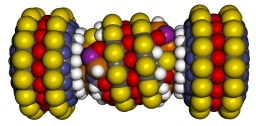| Nanotechnology: A New Environmental Tool? |
 Nanotechnology, operating at the level of atoms and molecules, has the potential to become a new kid on the environmental protection block. Useful applications of this supertech system may include revolutionary advances in pollution prevention, sensors, and waste treatment and remediation, altogether an environmental toolkit for the 21st century. Through EPA’s Science to Achieve Results (STAR) grant program, almost $6 million in support has been given to 16 universities to study this emerging technology. Nanotechnology, operating at the level of atoms and molecules, has the potential to become a new kid on the environmental protection block. Useful applications of this supertech system may include revolutionary advances in pollution prevention, sensors, and waste treatment and remediation, altogether an environmental toolkit for the 21st century. Through EPA’s Science to Achieve Results (STAR) grant program, almost $6 million in support has been given to 16 universities to study this emerging technology.
| Nanotechnology |
| • | What exactly is nanotechnology? |
| • | Does it have anything to do with the environment? |
| • | Is EPA involved? |
|
In layman’s terms, nanotechnology can be described as the ability to work at the molecular level, atom-by-atom, to create structures with fundamentally new organizations and characteristics. These tiny particles are at the nanometer scale – one billionth of a meter. But they are not so small that they can escape detection by the scanning tunneling microscope and the atomic force microscope, which not only "see" single atoms but, with a nanoscale-sized arm, can push and pull them into place, akin to putting up a building brick by brick.
Scientists are now experimenting with such items as nanocrystals, self-assembling nanolayers, nanotubes stronger than steel, protein machines that induce muscles to flex, and "smart" materials that return to their original shape when stimulated. STAR researchers, part of a government-wide effort that doubled in funding from FY 2000 to FY 2001, are pursuing a highly practical goal: a "green" nanotechnology which puts this fast-developing knowledge to work for a cleaner environment. For example, STAR funding at Lehigh University is helping to optimize and scale up the synthesis of nanosized particles for groundwater cleanup. Other researchers at the University of California/San Diego are developing a solid-state nano-based sensor for real-time, remote detection of certain heavy metals, facilitating the process of tracking and treating these pollutants. At the University of Delaware, researchers funded by STAR are studying the capacity of nanoparticles to treat automobile exhaust gas, replacing expensive platinum group metals and thus reducing the cost of pollution control. that doubled in funding from FY 2000 to FY 2001, are pursuing a highly practical goal: a "green" nanotechnology which puts this fast-developing knowledge to work for a cleaner environment. For example, STAR funding at Lehigh University is helping to optimize and scale up the synthesis of nanosized particles for groundwater cleanup. Other researchers at the University of California/San Diego are developing a solid-state nano-based sensor for real-time, remote detection of certain heavy metals, facilitating the process of tracking and treating these pollutants. At the University of Delaware, researchers funded by STAR are studying the capacity of nanoparticles to treat automobile exhaust gas, replacing expensive platinum group metals and thus reducing the cost of pollution control.
Another EPA program is supporting nanotechnology research by small businesses. EPA’s Small Business Innovation Research (SBIR) program is financing 11 projects for nearly $1 million related to nanotechnology development. These projects range from a nanocomposite-based filter for arsenic removal in drinking water to nanofibrous manganese dioxide for emission control of volatile organic compounds (VOCs).
Alongside the vision of nanotechnology that could lead to big advances in environmental protection are questions related to the potential environmental concerns that could be associated with this new technology. Could hazardous material be released into the environment during the use or manufacture of nanotechnologies? Could nano applications lead to biological harm by possibly accumulating in cellular material? We have begun to address these issues under the STAR program but much new research is still needed to fully understand if there are any environmental implications related to nanotechnology. Future research will answer many of our questions and determine whether nanotechnology is a vital new tool arriving just in time.
For more information about EPA’s STAR grants on nanotechnology visit: 2001 Exploratory Research: Nanotechnology STAR Recipients.
To learn more about EPA’s SBIR nanotechnology efforts see: Nano Alumina Arsenic Filter.
For more information, contact Estella Waldman at Waldman.Estella@epa.gov.
|